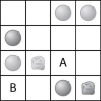After reading the paragraphs below, answer the questions that follow.
During a summer study abroad program, you travelled to Austria to study genetics at the University of Vienna. While you were there, a momentous discovery was made: some of Gregor Mendel's original lab books and notes were found to be buried outside of the abbey where he lived. It just so happened that the professor you were working with obtained copies of these notes and enlisted your help to decipher them.
You hired a translator to translate Mendel's notes from Czech to English, and using your knowledge of modern genetics (which Mendel did not have!) you were able to construct a partial Punnett square (shown below) . Because the notebook was damaged from being buried for so long, this is the only information that you have regarding a cross that Mendel must have performed. Your professor has tasked you with figuring out more about this experiment.

-In pea plants, round peas are dominant (R) and shriveled peas are recessive (r) and yellow peas (shown as light gray in Punnett square) are dominant (Y) and green peas (dark gray) are recessive (y) . Using this information and the partial Punnett square above, what were the phenotypes of the parental plants that were used in this cross by Mendel?
Definitions:
Variable Cost
Costs that vary directly with the level of production or sales volume, such as materials and labor.
Theory of Constraints
A management approach that focuses on identifying and managing the most limiting factor (constraint) that stands in the way of achieving a goal.
Goldratt and Cox
Eliyahu M. Goldratt and Jeff Cox, co-authors of "The Goal," a book introducing the Theory of Constraints, a methodology for improving organizational performance.
Net Present Value
The difference between the present value of cash inflows and the present value of cash outflows over a period of time, used in capital budgeting to assess the profitability of investments.
Q10: A cell that has a cell wall
Q15: Which step of the citric acid cycle
Q23: Two chromosomes in a nucleus that carry
Q35: Why is the runoff from fertilized agricultural
Q43: Which of the following statements about treatment
Q44: The way that genetic material of a
Q54: One hypothesis explaining animals' abilities to detect
Q56: The hair cells in the utricle detect<br>A)subsonic
Q62: Most plants can absorb and use which
Q76: Crossing over _ genes into assortments of